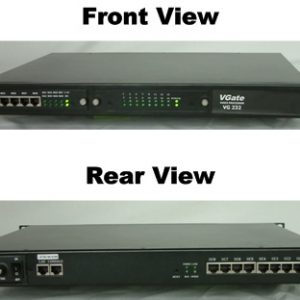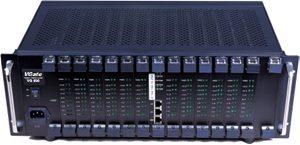Products
Voice Processor VGate 900 Series
VoIP Media Trunk Gateway/E1 to SIP VoIP Gateway is digital VoIP gateway converts signaling/voice media between digital TDM connections and VoIP connections, which brings the cost savings of VoIP to your legacy PBX with the powerful combination of Niceuc VoIP Media Gateway. The gateway acts as a bridge connecting the legacy system through a PRI interface to SIP trunks through your existing internet connection. Niceuc Gateways instantly upgrade a legacy phone system, allowing it to use a SIP trunk out to an ITSP; and connects SIP Trunking to reduce long-term telephony costs by replacing traditional phone lines.
VG Series VoIP media gateway is a cost effective and standards-compliant VoIP Media Trunk Gateway from E1/T1 to Ethernet, which is generally called TG (Trunking Gateway) or SG (Signaling Gateway) or VoIP Voice Gateway, designed for enterprise users and ITSP (Internet Telephony Service Provider) environments.
Three models VG900 / VG916 / VG1000 locate on the interface of PSTN / TDM and IP network, providing signaling transformation between SS7, ISDN PRI, R2/CAS, Q.SIG, V5.2, DPNSS signaling and SIP Protocol, as well as perform the conversion between PSTN / TDM and VoIP SIP.
With modular design, it’s easily expandable from 1 to 52 E1/T1 ports.
Description
Capacity:
1U device VG900 has two slots for E1 card, 2U device VG916 has four slots for E1 card, and 3.5U device VG1000 has thirteen slots for E1 card;
All three models use the exactly same E1 card.
With modular design, it’s easily expandable from 1 to 52 E1/T1 ports.
Specification of per E1 card:
-One independent IP address;
-1 to 4 E1 / T1 ports;
-2 Ethernet ports (10/100/1000M Base-T) and 1 console ports (RS232); -128 G.711 Channels;
-64 G.723, G.726, G.729 Channels;
-32 T.38 Fax Channels, 64 Conference Bridge;
-500 SIP Subscribers (it can also work as IP PBX at same time)
Signaling and Protocol:
~ Signaling support:
-SS7 (ITU-T Q.700 series), 24 bits/14 bits PC, ISUP/TUP; -ISDN-PRI (ITU-T Q.931, Q.921);
-V5.2 (ITU-T G.964, G.965)
-R2/CAS
-Q.SIG
-DPNSS
~ VoIP protocol support:
VoIP protocol support:
RFC3326 (Reason header in SIP messages)
RFC3372 (SIGTRAN and SIP-T)
RFC2327 (sdp)
RFC3398 (ISUP-SIP Mapping)
RFC3261 (sip)
RFC5806 (Diversion Indication in SIP)
RFC2833 (DTMF)
RFC3362 (t.38)
RFC 3261(SIP 2.0)
RFC3204 (MIME media types for ISUP and QSIG Objects)
RFC3578 (Mapping of ISUP overlap to SIP)
~ Codec:
G.711 U-Law and A-Law, G.711 Appendix 1, G.723.1 and G.723.1 Annex A, G.729 Annex A and Annex B, G.726,GSM,ARM, ILBC
~ Echo Cancellation: G.168 128 ms Network Echo Canceller
~ FAX: T30, T38 and pass through
~ Generic Voice Activity Detection (VAD)
~ Generic Comfort Noise Generation (CNG)
~ Calling control: Called/Calling party number translation; second stage dialing, Auto dialing with DTMF, Ring Back tone, DTMF, Caller ID, and Flexible input/output Gain Control.
~ Network Protocol: IP, NAT, ICMP, ARP, HTTP, BOOTP, FTP, TFTP, DHCP, PPPOE,SNMP, Diff-Serv




